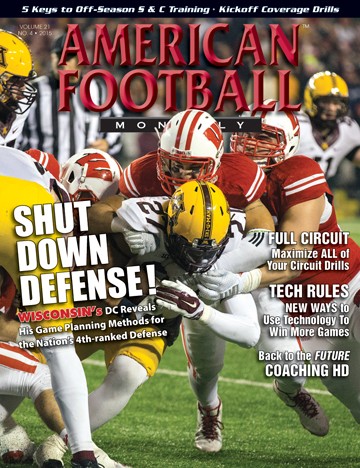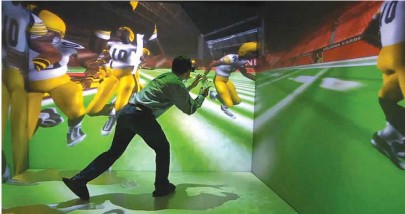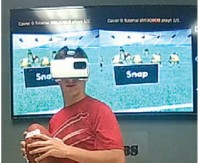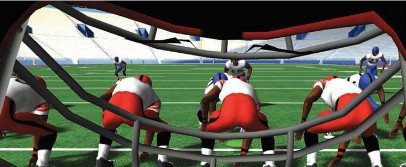Article CategoriesAFM Magazine
|
Coaching HD: Train the Brainby: Keith GrabowskiOffensive Coordinator Baldwin-Wallace College © More from this issue Over the past year, there has been tremendous growth in the realm of virtual reality (VR) and augmented reality (AR) applications in football. The idea of training the brain to function in a number of different situations has merits in terms of gaining experience as well as performing in a setting where the dangers of injury are removed. Data on these simulations show that performance on the field is improved. Cognition training provides an additional way for preparing the brain for high speed, high stakes competition. Like AR/VR, it involves training the mental processes so the body can react properly in the live game situations. Another related area is vision training. Vision training affects how the brain processes visual inputs and has proved to decrease the incidence of concussions on the field. With concussion and safety of players being a major issue in the game as well as the implications of enhanced performance, methods used to train the brain hold great interest for the football community. Virtual reality has gained the attention at the highest levels of football. Football is a difficult game to practice with all 22 players. There is a very finite number of practice repetitions available. Getting the first team quarterback prepared is of the utmost importance; therefore, he will receive the majority of the practice repetitions. Subsequently, coaches and players rely heavily on film study to gain experience with what happens on the field, but it never truly replaces the live repetition. New Orleans Saints Head Coach Sean Payton sees VR as a solution to this problem. At the MIT Sloan Sports Analytics Conference, Peyton spoke on utilizing virtual reality to train quarterbacks. He sees the advantages in the added repetitions that a quarterback can receive. �The challenge we have all the time is that it�s the one position where there�s only one of them in the game the entire time,� Payton said. �How do you get those guys snaps, real-time snaps?� Two companies are at the forefront of the VR/AR revolution in football � Eon Sports VR and STRIVR Labs, Inc. Eon Sports VR provides a very affordable solution for coaches at all levels. Their initial study showed up to 60% improvement in pre-snap reads and in game decisions. Quarterbacks see the field better and their decisions improve. CEO Brendan Reilly believes that in the not too distant future, a VR headset or AR goggles will become part of a football player�s training equipment. He also sees that the EON�s virtual reality solution provides efficiency in teaching for the coach. Reilly said that the biggest advantages they see when adopting the technology is that it is a time saver. �At first, it doesn�t seem like it because there is some up front work,� said Reilly. �But coaches who adopt it find that they spend less time having to focus on the minutiae because their kids understand faster. Additionally, coaches can automate the coaching process. For instance, a coach could set up a scenario for his QBs. Instead of having five different lessons, they can set up different scenarios and have the athletes self-pace the learning process. That�s powerful!� As Reilly indicates, individualized learning is one of the advantages of virtual reality. If a player is struggling recognizing and reacting properly to his key, for example, the coach can train those in the simulator before or after practice. As Payton envisions, the VR simulator becomes a place for the inexperienced player to gain practice repetitions. On his website Reilly points out the cumulative effect of the increased reps on a player�s experience: �A sophomore in high school could potentially be exposed to the same amount of repetitions as a junior in college! Imagine your senior QB operating the field and reading defenses like Peyton Manning! The amount of repetitions a player can get by training in SIDEKIQ is 240% more than traditional methods� and that is just using it two times a week.� (See photos of Eon Sports VR football simulators).
A user interacting with SIDEKIQ being shown in a life-size VR environment called the ICube.
(Above) QB using the SIDEKIQ VR Smartphone Simulator headset with his phone. His viewpoint is being streamed via chromecast to the TV. (Below) First person perspective from the quarterback�s viewpoint in SIDEKIQ.
In addition, virtual reality can serve to provide repetitions of scenarios that are less likely to occur but for which the coach wishes the player to be prepared. For example, in game film breakdown, a team may have shown a blitz only once. To this point in the season, it hasn�t been a big part of what they do, but if they choose to use it, it could present a problem. The coach may have only the repetitions available to show it once or twice during the course of the week, but it may be available for extra repetitions in the VR simulator. Stanford University professor Jeremy Bailenson and former kicker Derek Belch have developed STRIVR Labs, Inc. They are working on utilizing video captured in practice to simulate the work done on the field. The process involves �stitching� together video taken from different angles in order to put a player in a real video of a play. Former Stanford quarterback and VP at STRIVR Labs, Inc. Trent Edwards demonstrated the technology at Stanford�s Graduate School of Business Sports Innovation Conference. He became so immersed in what he was seeing in his headset that he almost walked off the stage. Edwards pointed out the reaction of the coaching community to STRIVR has been very positive. The Denver Broncos and Dallas Cowboys are soon to be clients and several SEC schools are in talks with the company. Stanford Head Coach David Shaw really believes in the project. He spoke with Fox Sports� Bruce Feldman on �The Audible.� In regard to how it�s the next best way to a quarterback learning on the field, Shaw said, �It�s not on paper. It�s not watching on TV. He�s learning from in the pocket. We are all visual creatures, and he can learn something visually without doing it physically; your body can react quicker because �I�ve seen this before.�� Shaw sees how it�s beneficial for players who are not starters, like a third team quarterback. �Multiple times in the NFL, at least four times, we have that � guys not getting any reps. He�s not getting any practice time. If that guy can spend 10-15 minutes a week and he�s thrown into active duty�he�s mentally and emotionally and visually been there�Your body doesn�t know the difference�If I can get the quarterback�s mind to feel like �I�ve been here before,� he can make quicker decisions. He can anticipate what�s going to happen which greatly increases his chances for success.� Belch has seen Shaw�s enthusiasm as well as understanding. Belch points out that part of virtual reality is that it develops empathy. �One of the coolest things we�ve seen is at Stanford,� said Belch. Coach Shaw actually puts the headset on and watches it. He says, �Ok. Now I see why he didn�t throw it here,� or conversely, �Why didn�t he throw it here based on what I am seeing?�� The coach now easily understands why a player made the decisions he did because he can see it from the player�s vantage point. This type of understanding better allows the coach to reach the heart and mind of his player. While most of the conversation on the technology revolves around training quarterbacks, the AR/VR tools certainly have applications beyond the quarterback position. Pre-snap processes apply to every position on both sides of the ball. Whether it�s a linebacker recognizing a formation and verbally making his checks to the defense, or an offensive tackle reading a triangle to understand which defender will be moving toward his gap, the mental work a player must do can be trained easily with VR/AR. It can be used to teach defensive backs and linebackers to pattern read routes or to execute their run fits. Having the ability to make quick decisions on the move is important for a running back. The VR simulations can aid in improving his vision and reaction needed to exploit the running lanes that a defense leaves open. Outside of the area of AR/VR, vision training provides a positive impact on performance as well as a method for diagnosing, managing, and decreasing concussions. Former CFL player Phil Jones developed Dynavision in 1989. Since then, Dynavision has become the industry leader with its FDA cleared medical evaluation, rehabilitation, and sports training devices. The Dynavision D2� light board measures performance and records the data to track improvement. It improves reaction times, visual-motor coordination, and peripheral visual awareness. What does that mean for a football player? It means that they use those improved skills to make faster, smarter decisions. The quarterback develops skills to see the entire field while remaining focused on his downfield receivers. The increased peripheral vision has applications for other positions as well. Defensive backs can better see a receiver coming into their zone or a blocker coming at them from an angle. Receivers who must adjust routes on the run can make quicker decisions and improve execution. The quarterback can see a hit coming in his peripheral vision and step up in the pocket to avoid it. Running backs can improve their ability to see cut backs or open running lanes. Visual recognition is a key component to success on the football field. Jones pointed out that Dynavision training has shown to decrease concussions by approximately 90%.This was based on a study done with the University of Cincinnati football team. Dynavision recognized the need for visual training for football because of the way players must diagnose a play visually while tracking targets as well as avoiding big hits that have the potential to cause injury. Improving the field of vision and reaction time through their protocols makes this training tool very valuable. In an article on Dynavision in Optometry & Visual Performance it was noted: �At the conclusion of the 2014 season (the 5th season of vision training), the University of Cincinnati football team had 3 diagnosed concussions. This makes it 5 years with 3 or fewer concussions per season since the initiation of vision training.� These are results that should catch every coach�s attention, given the place that concussion awareness and prevention has taken in this sport. Having a training tool that actually decreases the chance for concussion is of great value at any level of the game. Axon Sports is another company focused on training above the neck. Axon�s focus is in athletic cognitive skills, fundamental cognitive skills, and athletic cognitive consolidation. The process begins with improving processing speed, attention, learning, and working memory. Layered on top of that are pattern recognition and decision making skills, and finally focus and emotional regulation. The player learns to use the processes he is coached in while remaining cool, calm, and collected. The high pressure situations become something he is used to performing in, and he is able to do so without being negatively affected by his emotions. Training above the neck allows the players to see more and more repetitions. Axon allows the athlete to leverage the experience on iPads. �The brain needs to be protected, but also needs to be trained,� said Axon Sports President Jason Sada. �There is a tremendous upside (with brain training). Elite athletes leverage information made in instantaneous reads by subtle biomechanics cues.� Sada pointed out that brain training protocols enable athletes to train their responses to all the visual input they receive to make fast and accurate decisions. Some tasks are critical to be performed on the field like learning technique and fundamentals that build muscle memory, but others that involve mental processes can be trained much more efficiently with technology. The coaches� conventions and clinics have plenty of attention grabbing booths that show the shiny chrome helmets or the latest piece of weight room equipment. Those are all very nice and neat, tangible items to present to a booster club for funds. However, the best investment that can be made right now is the technology that helps train players year round. The extra repetitions in a safe environment prepare them for success on the field. The answer isn�t necessarily trying to squeeze more and more play repetitions into a practice and forcing the staff to coach off of film. The answer is in using training tools that teach, coach, and create a learning environment for the most important piece of equipment that a player has � his brain.
|
|
| HOME |
MAGAZINE |
SUBSCRIBE | ONLINE COLUMNISTS | COACHING VIDEOS |
Copyright 2025, AmericanFootballMonthly.com
All Rights Reserved







